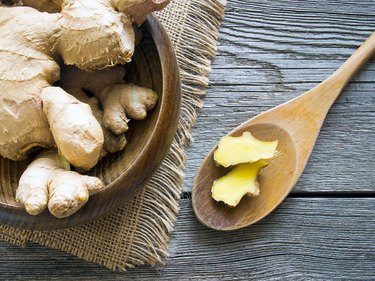
Pickled ginger, sometimes called Japanese pickled ginger or Gari, is white-beige to pale pink. Made from thinly shaved pieces of young ginger — before ginger develops its papery skin — pickled ginger is commonly served alongside sushi. Pickled ginger sometimes contains food dye or shiso leaves to give it a light pink color. Like fresh ginger, pickled ginger is rich in antioxidants, and it also has the added health benefits that come from vinegar.
Tip
Pickled ginger is low in calories and filled with the same health-promoting nutrients as fresh ginger, making it a healthy addition to your diet.
Video of the Day
Low in Sodium
Pickled ginger is high in flavor but low in sodium. A 1-tablespoon serving has 20 calories and 100 milligrams of sodium. You can use it in place of less healthy foods, such as soy sauce, for seasoning. While 1 tablespoon of soy sauce has fewer calories, only 11, it contains a lot more sodium, with 1,005 milligrams per serving. The recommended upper intake of sodium is 2,300 milligrams, with a lower recommendation, 1,500 milligrams, for adults who are over the age of 50, have a history of cardiovascular trouble or are African American. While a serving of pickled ginger provides 4.3 to 6.7 percent of the recommended sodium intake, soy sauce has 44 to 67 percent of the recommended intake. A diet high in sodium is associated with high blood pressure and an increased risk of osteoporosis, according to Colorado State University Extension.
Video of the Day
Rich in Antioxidants
A study published in 2004 in "Biofactors" found that ginger contained over 50 different antioxidants, among them gingerol. The researchers found that ginger's antioxidants had strong scavenging effects, potentially providing crucial protection to your body. Antioxidants are natural compounds that can potentially help prevent or delay harm to your body's cells.
Benefits of Pickling
Pickled ginger is made by exposing thin slices of young ginger to a pickling solution, a blend of vinegar, sugar and salt. Traditionally, kombu, a dried seaweed, is also used to provide extra flavor. Because pickled ginger has a high vinegar content — which is what gives it its sour taste — it may help reduce body weight as well as overall body fat. A study in a 2009 issue of "Bioscience, Biotechnology and Biochemistry" found that including vinegar regularly in the diet led to lower overall body weight, a smaller waist circumference and less overall body fat. However, as the study used a 15-milliliter vinegar supplement per day, more than is commonly found in a serving of pickled ginger, pickled ginger alone may not produce the same effects, but may help you get closer to your weight goals.
Using Pickled Ginger
Pickled ginger is often used as a condiment to offset the fatty richness of the fish used in sushi. It can also be used in cooked and raw dishes, where its distinctive sourness and mild spiciness add a bright flavor to foods. You can use pickled ginger in a soy-sauce-flavored stir-fry, or even include it in fried rice, adding it during the cooking process or serving it alongside the rice. Pickled ginger can also be sliced into thin strands and used in salads, or the pickling juice can be used in place of vinegar for an Asian-influenced salad dressing.
- VietWorld Kitchen: Japanese Pickled Ginger (Gari)
- Biofactors: Antioxidant Properties of Gingerol Related Compounds From Ginger
- Bioscience, Biotechnology and Biochemistry: Vinegar Intake Reduces Body Weight, Body Fat Mass, and Serum Triglyceride Levels in Obese Japanese Subjects
- Taste.com: Soy Chicken With Pickled Ginger Soba Noodles
- Serious Eats: Dinner Tonight - Mushroom Fried Rice With Pickled Ginger
- MedlinePlus: Antioxidants
- Eden Foods: Pickled Ginger With Shiso Leaves
- USDA National Nutrient Database: Soy Sauce (Tamari)
- Colorado State University Extension: Sodium and the Diet